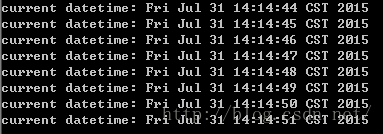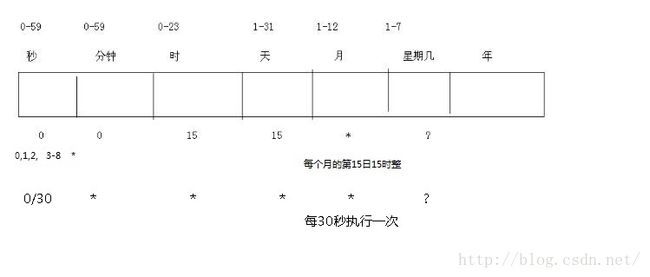@Scheduled执行定时任务与cron表达式
1 配置文件形式执行定时任务
1 1.X 版本与spring结合使用实例
1.1 常用maven管理 pom.xml文件
4.0.0
com.kevin.quartz
quartz
war
1.0
quartz1.x
http://maven.apache.org
UTF-8
3.2.14.RELEASE
org.apache.maven.plugins
maven-war-plugin
false
org.apache.maven.plugins
maven-source-plugin
attach-sources
jar-no-fork
org.apache.maven.plugins
maven-compiler-plugin
1.6
1.6
${artifactId}
javax.servlet
servlet-api
2.5
provided
junit
junit
4.10
test
log4j
log4j
1.2.16
org.springframework
spring-core
${spring.version}
org.springframework
spring-context
${spring.version}
org.springframework
spring-beans
${spring.version}
org.springframework
spring-web
${spring.version}
org.springframework
spring-webmvc
${spring.version}
org.springframework
spring-aop
${spring.version}
org.springframework
spring-jdbc
${spring.version}
org.springframework
spring-tx
${spring.version}
org.springframework
spring-orm
${spring.version}
org.springframework
spring-context-support
${spring.version}
org.springframework
spring-expression
${spring.version}
org.springframework
spring-test
${spring.version}
org.springframework
spring-aspects
${spring.version}
aopalliance
aopalliance
1.0
org.aspectj
aspectjweaver
1.8.6
org.quartz-scheduler
quartz
1.8.6
2 定义我的工作类
package com.kevin.quartz.job;
import java.util.Date;
public class MyJob {
public void work() {
System.out.println("current datetime: " + new Date().toString());
}
}3 Spring配置文件
work
0/1 * * * * ?
4 Web.Xml配置
contextConfigLocation
/WEB-INF/classes/applicationContext.xml
org.springframework.web.context.ContextLoaderListener
5 运行及效果
2 2.X与spring结合使用案例
1 maven管理项目 pom.xml
4.0.0
com.kevin.quartz
example1
jar
1.0
example1
http://maven.apache.org
UTF-8
4.0.0.RELEASE
org.apache.maven.plugins
maven-compiler-plugin
1.6
1.6
org.apache.maven.plugins
maven-source-plugin
attach-sources
jar-no-fork
${artifactId}
junit
junit
4.10
test
log4j
log4j
1.2.16
org.springframework
spring-core
${spring.version}
org.springframework
spring-context
${spring.version}
org.springframework
spring-beans
${spring.version}
org.springframework
spring-web
${spring.version}
org.springframework
spring-webmvc
${spring.version}
org.springframework
spring-aop
${spring.version}
org.springframework
spring-jdbc
${spring.version}
org.springframework
spring-tx
${spring.version}
org.springframework
spring-orm
${spring.version}
org.springframework
spring-context-support
${spring.version}
org.springframework
spring-expression
${spring.version}
org.springframework
spring-test
${spring.version}
org.springframework
spring-aspects
${spring.version}
aopalliance
aopalliance
1.0
org.aspectj
aspectjweaver
1.8.6
org.quartz-scheduler
quartz
2.2.1
2 定义我的工作类
package com.kevin.quartz;
public class MyJob {
public void execute(){
System.out.println("starting ...");
System.out.println("this is quartz job executing ...");
System.out.println("ending ...");
}
}
3 在spring中配置
4 测试类效果
package com.kevin.quartz;
import org.junit.Test;
import org.junit.runner.RunWith;
import org.springframework.test.context.ContextConfiguration;
importorg.springframework.test.context.junit4.SpringJUnit4ClassRunner;
@RunWith(SpringJUnit4ClassRunner.class)
@ContextConfiguration(locations = "classpath:quartz-beans.xml")
public class QuartzTest {
@Test
public void testExecute() {
try {
Thread.sleep(1000 * 10); //此处是为了看到效果
} catch (InterruptedException e) {
e.printStackTrace();
}
}
}starting ...
this is quartz job executing...
ending ...
starting ...
this is quartz job executing...
ending ...因为项目仅执行10秒
任务每5秒执行一次
所以一共就只有2次执行
2 @Scheduled注解执行定时任务
1 注解类型:@EnableScheduling @Scheduled
@Target(value=TYPE)
@Retention(value=RUNTIME)
@Import(value=SchedulingConfiguration.class)
@Documentedpublic
@interface EnableScheduling
使用 @EnableScheduling 注解的类示例:
@Configuration
@EnableScheduling
public class AppConfig {
// 各种@bean的定义
// various @Bean definitions
}使用@Scheduled注解可以被Spring容器检测。使用示例:
package com.myco.tasks;
public class MyTask {
@Scheduled(fixedRate=1000)
public void work() {
// 任务执行逻辑
// task execution logic
}
}下面的配置使MyTask.work()每1000毫秒被执行一次:
@Configuration
@EnableScheduling
public class AppConfig {
@Bean
public MyTask task() {
return new MyTask();
}
}如果MyTask使用了@Component注解,下面的配置方式也可以让使用了@Scheduled注解的方法在设置的时间间隔里面被调用:
@Component //import org.springframework.stereotype.Component;
public class MyTask {
@Scheduled(cron="0/5 * * * * ? ") //每5秒执行一次
@Override
public void myTest(){
System.out.println("进入测试");
}
} @Configuration
@ComponentScan(basePackages="com.myco.tasks")
public class AppConfig {
}使用了@Scheduled注解方法也可以在使用了@Configuration注解的类里面使用:
@Configuration
@EnableScheduling
public class AppConfig {
@Scheduled(fixedRate=1000)
public void work() {
// task execution logic
}
}上面介绍的都是在单线程的情况下执行任务调度的。
如果希望进行更多的控制,我们可以让使用@Configuration注解的类实现SchedulingConfigurer接口,这样就可以访问底层的ScheduledRegistrar实例。
下面的例子演示如何定制Executer去执行任务计划:
@Configuration
@EnableScheduling
public class AppConfig implements SchedulingConfigurer {
@Override
public void configureTasks(ScheduledTaskRegistrar taskRegistrar) {
taskRegistrar.setScheduler(taskExecutor());
}
@Bean(destroyMethod="shutdown")
public Executor taskExecutor() {
return Executors.newScheduledThreadPool(100);
}
}注意上面例子中使用的@bean(destroyMethod="shutdown")。
这样是为了确保当Spring应用上下文关闭的时候任务执行者也被正确地关闭。
实现SchedulingConfigurar接口还允许细粒度控制任务通过ScheduledTaskRegistrar进行登记。
例如,下面的配置使用自定义的Trigger执行bean的方法
@Configuration
@EnableScheduling
public class AppConfig implements SchedulingConfigurer {
@Override
public void configureTasks(ScheduledTaskRegistrar taskRegistrar) {
taskRegistrar.setScheduler(taskScheduler());
taskRegistrar.addTriggerTask(
new Runnable() {
public void run() {
myTask().work();
}
},
new CustomTrigger()
);
}
@Bean(destroyMethod="shutdown")
public Executor taskScheduler() {
return Executors.newScheduledThreadPool(42);
}
@Bean
public MyTask myTask() {
return new MyTask();
}
}作为参考,上面的例子和下面使用XML配置方式的作用是一样的:
3 cron表达式
CronTrigger配置格式:
[秒] [分] [小时] [日] [月] [周] [年]
序号 说明 是否必填 允许填写的值 允许的通配符
1 秒 是 0-59 , - * /
2 分 是 0-59 , - * /
3 小时 是 0-23 , - * /
4 日 是 1-31 , - * ? / L W
5 月 是 1-12 or JAN-DEC , - * /
6 周 是 1-7 or SUN-SAT , - * ? / L #
7 年 否 empty 或 1970-2099 , - * /
1 秒 是 0-59 , - * /
2 分 是 0-59 , - * /
3 小时 是 0-23 , - * /
4 日 是 1-31 , - * ? / L W
5 月 是 1-12 or JAN-DEC , - * /
6 周 是 1-7 or SUN-SAT , - * ? / L #
7 年 否 empty 或 1970-2099 , - * /
通配符说明:
* 表示所有值. 例如:在分的字段上设置 "*",表示每一分钟都会触发。
? 表示不指定值。使用的场景为不需要关心当前设置这个字段的值。例如:要在每月的10号触发一个操作,但不关心是周几,所以需要周位置的那个字段设置为"?" 具体设置为 0 0 0 10 * ?
- 表示区间。例如在小时上设置 "10-12",表示 10,11,12点都会触发。
, 表示指定多个值,例如在周字段上设置 "MON,WED,FRI" 表示周一,周三和周五触发
/ 用于递增触发。如在秒上面设置"5/15" 表示从5秒开始,每增15秒触发(5,20,35,50)。 在月字段上设置'1/3'所示每月1号开始,每隔三天触发一次。
L 表示最后的意思。在日字段设置上,表示当月的最后一天(依据当前月份,如果是二月还会依据是否是润年[leap]), 在周字段上表示星期六,相当于"7"或"SAT"。如果在"L"前加上数字,则表示该数据的最后一个。例如在周字段上设置"6L"这样的格式,则表示“本 月最后一个星期五"
W 表示离指定日期的最近那个工作日(周一至周五). 例如在日字段上设置"15W",表示离每月15号最近的那个工作日触发。如果15号正好是周六,则找最近的周五(14号)触发, 如果15号是周未,则找最近的下周一(16号)触发.如果15号正好在工作日(周一至周五),则就在该天触发。如果指定格式为 "1W",它则表示每月1号往后最近的工作日触发。如果1号正是周六,则将在3号下周一触发。(注,"W"前只能设置具体的数字,不允许区间"-").
小提示
'L'和 'W'可以一组合使用。如果在日字段上设置"LW",则表示在本月的最后一个工作日触发(一般指发工资 )
# 序号(表示每月的第几个周几),例如在周字段上设置"6#3"表示在每月的第三个周六.注意如果指定"#5",正好第五周没有周六,则不会触发该配置(用 在母亲节和父亲节再合适不过了)
小提示
周字段的设置,若使用英文字母是不区分大小写的 MON 与mon相同.
* 表示所有值. 例如:在分的字段上设置 "*",表示每一分钟都会触发。
? 表示不指定值。使用的场景为不需要关心当前设置这个字段的值。例如:要在每月的10号触发一个操作,但不关心是周几,所以需要周位置的那个字段设置为"?" 具体设置为 0 0 0 10 * ?
- 表示区间。例如在小时上设置 "10-12",表示 10,11,12点都会触发。
, 表示指定多个值,例如在周字段上设置 "MON,WED,FRI" 表示周一,周三和周五触发
/ 用于递增触发。如在秒上面设置"5/15" 表示从5秒开始,每增15秒触发(5,20,35,50)。 在月字段上设置'1/3'所示每月1号开始,每隔三天触发一次。
L 表示最后的意思。在日字段设置上,表示当月的最后一天(依据当前月份,如果是二月还会依据是否是润年[leap]), 在周字段上表示星期六,相当于"7"或"SAT"。如果在"L"前加上数字,则表示该数据的最后一个。例如在周字段上设置"6L"这样的格式,则表示“本 月最后一个星期五"
W 表示离指定日期的最近那个工作日(周一至周五). 例如在日字段上设置"15W",表示离每月15号最近的那个工作日触发。如果15号正好是周六,则找最近的周五(14号)触发, 如果15号是周未,则找最近的下周一(16号)触发.如果15号正好在工作日(周一至周五),则就在该天触发。如果指定格式为 "1W",它则表示每月1号往后最近的工作日触发。如果1号正是周六,则将在3号下周一触发。(注,"W"前只能设置具体的数字,不允许区间"-").
小提示
'L'和 'W'可以一组合使用。如果在日字段上设置"LW",则表示在本月的最后一个工作日触发(一般指发工资 )
# 序号(表示每月的第几个周几),例如在周字段上设置"6#3"表示在每月的第三个周六.注意如果指定"#5",正好第五周没有周六,则不会触发该配置(用 在母亲节和父亲节再合适不过了)
小提示
周字段的设置,若使用英文字母是不区分大小写的 MON 与mon相同.
常用示例:
0 0 12 * * ? 每天12点触发
0 15 10 ? * * 每天10点15分触发
0 15 10 * * ? 每天10点15分触发
0 15 10 * * ? * 每天10点15分触发
0 15 10 * * ? 2005 2005年每天10点15分触发
0 * 14 * * ? 每天下午的 2点到2点59分每分触发
0 0/5 14 * * ? 每天下午的 2点到2点59分(整点开始,每隔5分触发)
0 0/5 14,18 * * ? 每天下午的 2点到2点59分(整点开始,每隔5分触发) 每天下午的 18点到18点59分(整点开始,每隔5分触发)
0 0-5 14 * * ? 每天下午的 2点到2点05分每分触发
0 10,44 14 ? 3 WED 3月分每周三下午的 2点10分和2点44分触发
0 15 10 ? * MON-FRI 从周一到周五每天上午的10点15分触发
0 15 10 15 * ? 每月15号上午10点15分触发
0 15 10 L * ? 每月最后一天的10点15分触发
0 15 10 ? * 6L 每月最后一周的星期五的10点15分触发
0 15 10 ? * 6L 2002-2005 从2002年到2005年每月最后一周的星期五的10点15分触发
0 15 10 ? * 6#3 每月的第三周的星期五开始触发
0 0 12 1/5 * ? 每月的第一个中午开始每隔5天触发一次
0 11 11 11 11 ? 每年的11月11号 11点11分触发
0 0 12 * * ? 每天12点触发
0 15 10 ? * * 每天10点15分触发
0 15 10 * * ? 每天10点15分触发
0 15 10 * * ? * 每天10点15分触发
0 15 10 * * ? 2005 2005年每天10点15分触发
0 * 14 * * ? 每天下午的 2点到2点59分每分触发
0 0/5 14 * * ? 每天下午的 2点到2点59分(整点开始,每隔5分触发)
0 0/5 14,18 * * ? 每天下午的 2点到2点59分(整点开始,每隔5分触发) 每天下午的 18点到18点59分(整点开始,每隔5分触发)
0 0-5 14 * * ? 每天下午的 2点到2点05分每分触发
0 10,44 14 ? 3 WED 3月分每周三下午的 2点10分和2点44分触发
0 15 10 ? * MON-FRI 从周一到周五每天上午的10点15分触发
0 15 10 15 * ? 每月15号上午10点15分触发
0 15 10 L * ? 每月最后一天的10点15分触发
0 15 10 ? * 6L 每月最后一周的星期五的10点15分触发
0 15 10 ? * 6L 2002-2005 从2002年到2005年每月最后一周的星期五的10点15分触发
0 15 10 ? * 6#3 每月的第三周的星期五开始触发
0 0 12 1/5 * ? 每月的第一个中午开始每隔5天触发一次
0 11 11 11 11 ? 每年的11月11号 11点11分触发

